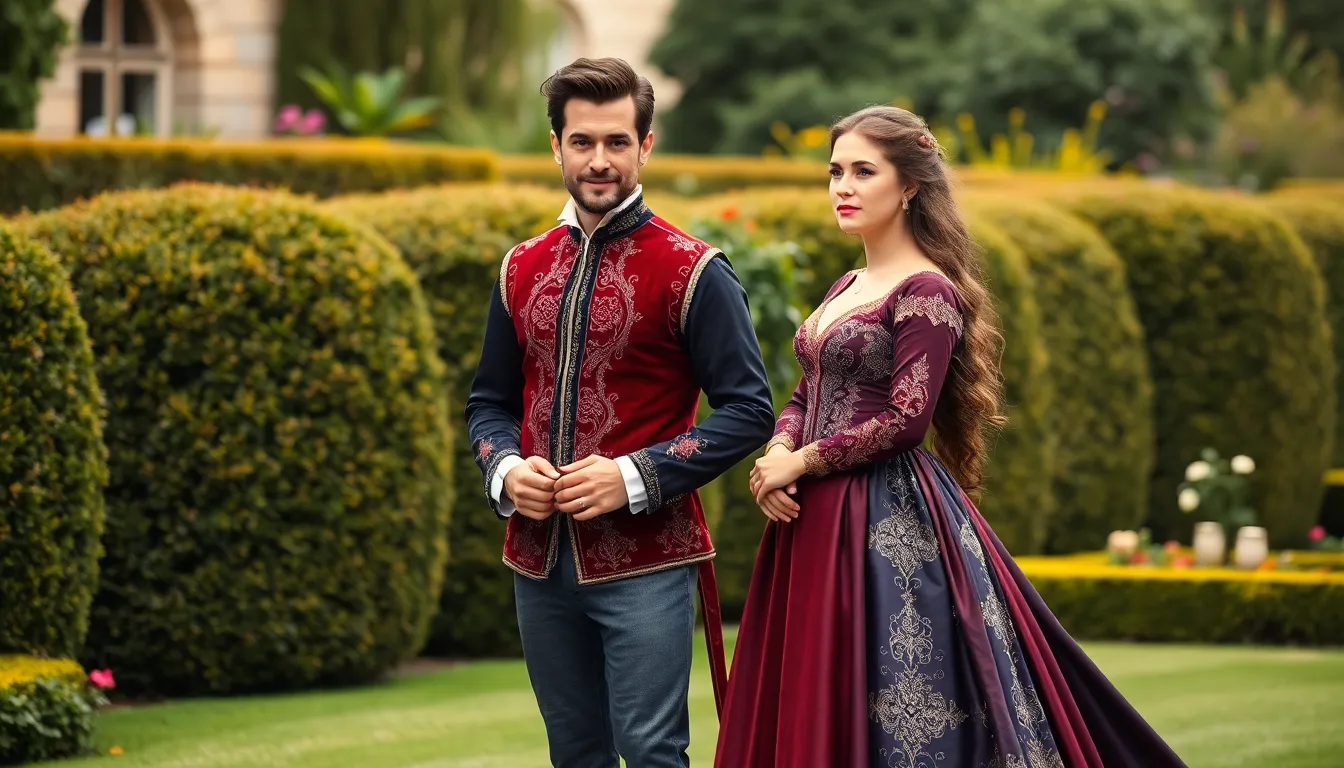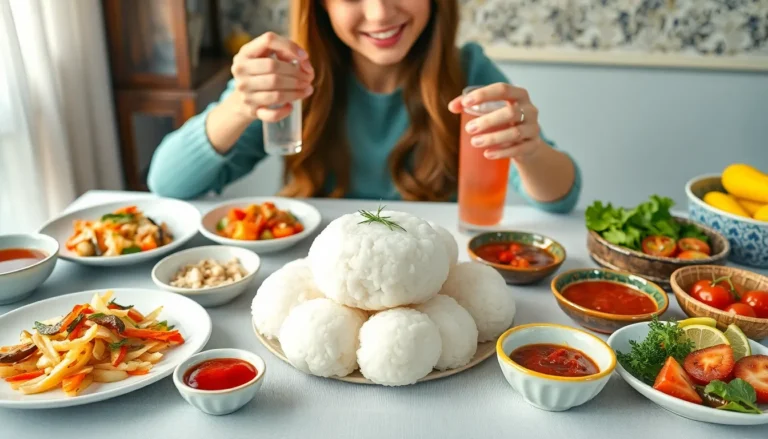Table of Contents
ToggleStep into a world where fashion was as extravagant as a knight’s quest for glory. Medieval formal wear wasn’t just about looking good; it was a statement of power, wealth, and social status. Imagine donning a flowing gown adorned with jewels or a dashing doublet that could make even the most stoic of kings crack a smile.
But let’s be real—while the fabrics were luxurious, the practicality might leave you wondering how anyone managed to sit down without a wardrobe malfunction. From the noble lords to the elegant ladies, medieval attire was a blend of artistry and absurdity that still sparks fascination today. Join the journey through time as we unravel the threads of medieval fashion, where every stitch tells a story and every outfit is a chapter in history.
Overview Of Medieval Formal Wear
Medieval formal wear reflects social hierarchies and wealth during the Middle Ages. Luxurious fabrics, such as silk and velvet, adorned the elite. Gowns for women often featured long trains and lavish embroidery, symbolizing both beauty and status. Doublets for men served as tailored garments, with intricate designs emphasizing craftsmanship.
Tippets and sleeves varied in length and style, showcasing personal taste. Color choices carried significant meaning, with purple denoting royalty and red representing power. Important occasions demanded opulent attire; thus, formal wear aimed to impress and convey one’s rank.
Fabrics often included brocade and damask, adding depth to garments. Heavy use of trim, such as fur and gold thread, enhanced the visual appeal. Accessories played a critical role in completing outfits, from jeweled belts to ornate cloaks.
Footwear also adapted to the formal nature of occasions. Pointed shoes, known as “poulaines,” gained popularity among nobles, further accentuating the fashion. Hats or headpieces introduced elaborate designs, with the wealthy showcasing their affluence through unique styles.
Women’s silhouettes evolved throughout the medieval period, with the introduction of the “cotehardie” that emphasized the waist. Men frequently layered garments, merging practicality with elegance. Tailoring techniques advanced, resulting in better-fitted clothing that flattered the body.
Medieval formal wear not only provided a glimpse into individual personalities but also reinforced societal roles. Each outfit told a story, intertwining personal identity with the era’s cultural backdrop. This attire remains a fascinating aspect of history, inviting exploration into the lives of those who wore it.
Historical Context

Medieval formal wear reflects a rich tapestry of cultural and social evolution. The styles and craftsmanship of the time tell a story beyond mere aesthetics.
The Evolution Of Fashion
Fashion underwent significant changes throughout the medieval period. Early styles were simple, focusing on practicality. As society progressed, opulence became key, influenced by trade and royal patronage. By the 14th and 15th centuries, garments became more elaborate. Gowns expanded with layers, while doublets introduced ornamentation. Tailoring skills advanced, allowing for more fitted silhouettes. As a result, clothing became a visual representation of wealth and status. The introduction of new materials—like silk from the East—transformed wardrobes. Overall, fashion’s evolution during this era mirrored social dynamics, showcasing both pastoral simplicity and urban extravagance.
Influences On Design
Several factors shaped the design of medieval formal wear. Religion influenced styles, dictating modesty and appropriateness in attire. Geographic location also played a role, with regional climates affecting fabric choices. Trade routes introduced exotic materials, enhancing luxury. Furthermore, monarchs set trends, with royal decrees sometimes dictating color and fabric specs. Nobility followed suit closely, ensuring alignment with the elite. Art and literature inspired motifs and patterns, with tapestries often reflecting themes seen in formal wear. Cultural exchange with neighboring regions enriched design approaches, resulting in a complex interplay of aesthetics. Such influences established a vibrant and evolving marketplace for medieval fashion.
Key Components Of Medieval Formal Wear
Medieval formal wear featured distinct characteristics that defined its elegance. The essence of these garments lies in their fabrics and colors.
Fabrics And Materials
Luxurious fabrics embodied the status of wearers. Silk and velvet were favorites among the elite, offering a touch of opulence. Wool also found its place in more practical settings, providing warmth during colder months. Linen served as a lightweight option, especially for those in warmer climates. Additionally, intricate embroidery embellished these garments, showcasing skilled craftsmanship. The availability of rare materials, often limited by trade routes, contributed to the exclusivity of certain garments.
Color Significance
Colors conveyed powerful messages in medieval society. Purple represented royalty, often reserved for kings and queens. Red signified power, frequently worn by the nobility. Green indicated youth and vitality, reflecting the wearer’s social aspirations. Subtle shades, like pastels, emerged in the 15th century, emphasizing fashion’s evolution. Color choices also played a role in denoting rank and status, illustrating a person’s place within the social hierarchy. These visual cues enriched the narrative of medieval life, serving as expressions of identity and wealth.
Styles By Social Class
Medieval formal wear varied significantly based on social class, with each tier showcasing its unique sartorial expressions. Clothing functioned as a visual indicator of wealth and rank.
Nobility Attire
Gowns and doublets for the nobility epitomized opulence. Crafted from rich materials like silk and velvet, these garments exuded luxury. Women often wore gowns adorned with long trains and intricate embroidery, signifying their high status. Men featured tailored doublets, enhancing their refined image through structured designs. Color choices also resonated with rank, with purple especially favored for its royal connotations. Accessories complemented these outfits, including ornate jewelry and elaborate headpieces, further underscoring their affluence. Notably, the elegance of noble attire conveyed power, authority, and distinction within the social hierarchy.
Merchant Class Clothing
Attire for the merchant class displayed both practicality and a sense of emerging wealth. Wool and linen formed the basis of their clothing, chosen for durability and comfort. While simpler than noble garments, merchant outfits featured vibrant colors and simple embellishments to reflect rising affluence. Women might don fitted dresses that allowed for ease of movement, paired with decorative belts that highlighted their shapes. Men wore tunics and breeches, often accentuated with simple embroidery or contrasting fabrics. The merchant class adopted fashion trends from nobility while balancing functionality, illustrating their important role in the burgeoning economy.
Regional Variations
Medieval formal wear presented distinct regional characteristics that captured the essence of local cultures and traditions. Understanding these variations enhances appreciation for the rich history of medieval fashion.
English Medieval Formal Wear
English formal attire often reflected the class structure, with noble clothing typified by elaborate designs and luxurious materials. Wealthy individuals wore gowns and doublets crafted from silk and velvet, featuring intricate embroidery and jewels. The iconic black robe known as the Parliament robe represented authority. Clothing colors frequently indicated social standing, with purple being reserved for the elite. Contrast in styles was clear; while nobility donned opulence, common folk wore simpler garments made of wool or linen.
French Influences
French medieval formal wear set trends across Europe, showcasing sophistication and artistry. Nobles favored flowing gowns and tailored doublets adorned with bright colors and lavish embellishments. The introduction of new styles, like the famous surcoat, influenced design throughout the continent. French fashion emphasized fit and detail, with an array of fabrics including damask and brocade. Moreover, the connection between French and English courts led to cross-cultural inspirations that elevated fashion standards across regions. Elaborate headwear, often crafted from fine materials, completed the striking ensemble, further underlining the cultural prominence of France in medieval attire.
Medieval formal wear stands as a testament to the intricate interplay of culture and status. Each garment tells a story of its wearer while reflecting the broader societal dynamics of the time. The evolution of styles and materials illustrates how fashion not only served practical purposes but also acted as a powerful symbol of identity.
From the lavish gowns of noblewomen to the tailored doublets of men, every detail mattered. The rich colors and luxurious fabrics conveyed messages of power and prestige. As trends shifted across regions, the influence of trade and artistry further enriched this vibrant tapestry of medieval fashion. Exploring these garments offers a unique glimpse into a fascinating era marked by elegance and complexity.






